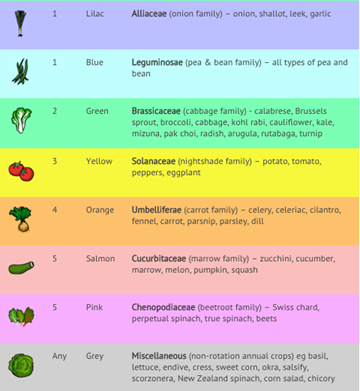Depending on the size of your garden, you can plan rotations that cover 3, 4, 5, 6 or more years, with 3 years being the minimum recommended.
As noted above, the best way to rotate annual vegetables is to group them by their plant family, since they are susceptible to the same pests and diseases and also have similar maintenance requirements. For instance, all plants in the cabbage family are best grown together, as this makes it easier to net them against cabbage moths and birds—and there’s no risk of accidentally passing on crop-specific soil-dwelling pests and diseases to the next crop.
A handy way to set crop order is to give each plant family a shade relating to the colors of the rainbow, as shown below. Using this order of rotation is optional, but it helps to make sure that the soil is in the correct condition for the following crop. The numbers listed in the diagram tell you

· Working from the inside of the rainbow out, you can see which plants belong together and which should come next in each bed. The rotation starts with lilacs and blues—onion family plants and peas/beans—which are commonly grown together as they both like soil enriched with compost and take up little space. Once you’ve harvested your onions and leeks from your first bed, the next crop in that spot would be cabbages, cauliflower and broccoli and so on, for the first seven categories.
· Plants in the Miscellaneous (grey) category are useful for plugging gaps in your beds, as they don’t tend to suffer badly from particular soil-borne pests and diseases, and can be fit in anywhere you have room, although it’s still a good idea to move them around from year to year as much as possible (particularly sweet corn, which can suffer from rootworm).
Rotating small gardens can be more challenging, given lack of space, but it’s still important. See our Four-Bed Crop Rotation Plan for Small Gardens.
Keeping a Record
Crop rotation is not as complicated as it sounds, but it can be hard to keep track of. Don’t rely on memory alone, particularly if you are growing different amounts of a variety of crops!
Just roughly sketch your garden and write down what you have planted where and by plant family. (It can also be helpful to keep a list of the variety names.)
